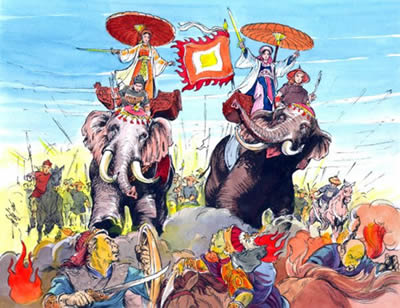 |
| Trung Sisters |
Trung Trac and Trung Nhi are sisters who led a failed revolt against Chinese rule in northern Vietnam between 40 and 43 c.e. and are honored as heroines in Vietnam. The Southern Yue (Yueh), or Nanyue, people are a branch of Mongoloids who lived in tribal society and practiced slash-and-burn agriculture along the coast of China in present-day Guangdong (Kwangtung) and Guangxi (Kuanghsi) Provinces and the northern part of presentday Vietnam.
The area was conquered during the reign of the first emperor of the Qin (Ch’in) dynasty between 220 and 210 b.c.e. and divided into three commanderies. When the Qin dynasty fell in 206 b.c.e., a man from northern China named Zhao Tuo (Chao T’o) proclaimed himself king of Nanyue and made his capital in modern Guangzhou (Canton). Gaozu (Liu Bang), the first emperor of the Han dynasty, confirmed Zhao as king, and a loose tributary relationship was established between Nanyue and Han.
In 113 b.c.e. the queen dowager of Nanyue, who was Chinese and wanted a close relationship with Han China, was murdered by her opponents. This action resulted in war between Han and Nanyue, the destruction of the kingdom, and its annexation by Han, which established nine commanderies in the former kingdom.
  |
Chinese rule resulted in economic advancement, with the introduction of irrigation and iron tools for agriculture. It also resulted in the gradual influx of Chinese immigrants to the best new lands, especially in the Red River valley.
Friction led to a revolt led by two sisters, surnamed Trung (Zheng or Cheng in Chinese transliteration), daughters of a local chief, in 40 c.e. One proclaimed herself queen. A number of local tribes from 65 towns and settlements joined their cause.
Emperor Guangwu (Kuang-wu) of the Han dynasty reacted slowly, waiting until 42 c.e. to appoint General Ma Yuan as commanding officer in charge of suppressing the revolt. An experienced general, Ma was given the title "general who calms the waves". He reached Guangdong in 43, sent his supplies via ships, and led the 10,000 troops overland to the Red River delta.
The campaign was quickly over, the sisters were captured and executed (some say they committed suicide), and the mopping up was completed by the end of the year. Ma returned to capital city Luoyang (Loyang) in 44 and presented the emperor with a huge bronze horse, cast with the bronze melted from Yue drums that symbolized the power of the chiefs.
Resistance to sinicization and Chinese immigration was the likely cause of this revolt and many other similar revolts by aboriginal peoples in the southern borderlands of the Han empire during the first and second centuries c.e. The primary cause was Chinese immigrants moving deeper into the river valleys and appropriating good land, either assimilating the natives or driving them to less accessible areas.
Some natives revolted, and the Han government felt compelled to put down the revolts to protect the Chinese settlements. Whereas Guangdong and Guangxi were eventually fully integrated into the Chinese state, Vietnam (Yuehnan in Chinese transliteration) became a separate state in the 10th century.
In light of this the rebellion led by the Trung sisters had nationalistic overtones, and for this reason they were revered as symbols of resistance to Chinese domination. General Ma Yuan became deified in Chinese popular religion and was especially revered in southern China.